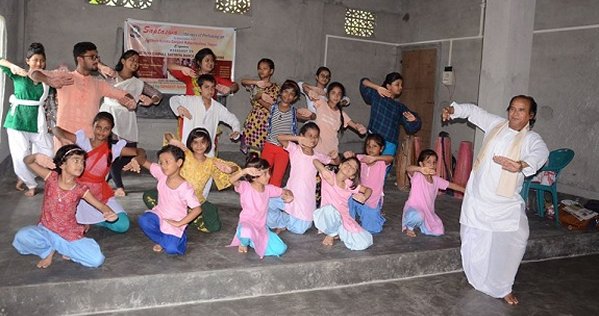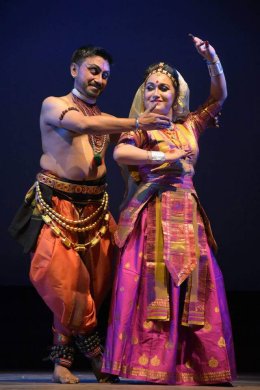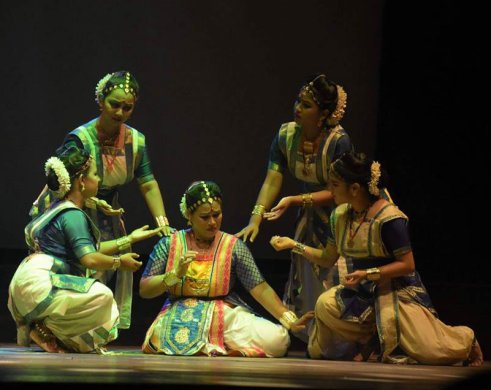
|   |

|   |
Sattriya workshop and performance - Jintu Sarma e-mail: jsarma88@gmail.com August 14, 2018 Dance is the sound of the soul. To be a dancer, passion is the foremost need. Assam is the land of Sattriya, one of the finest classical dance forms of India. The motivation to learn classical dance forms particularly among the upcoming generation is very important to promote the dance forms, particularly Sattriya in Assam to encourage the budding talents and to provide a national platform to the youth. Keeping in mind the objective, Saptaswa.....the Rays of Performing Art organized a Sattriya dance, Sattriya Ojapali and Khol playing workshop from 6 -15th July 2018 at Jyotikala Kendra Sangeet Mahavidyalaya, Tezpur. The program was supported by Sangeet Natak Akademi, New Delhi.   To conduct the workshop, Guru Haricharan Bhuyan Borbayan, a reputed Sattriya exponent of Assam hailing from Natun Kamalabari Sattra, Majuli, was invited as one of the resource persons. Ranjan Borah, Sattriya teacher of Na-duar Sangeet Mahavidyalaya and assistant teacher of Adaveti LP School was another resource person. The workshop was inaugurated on 6th of July by Krishna Das Nath, a teacher. About 35 children participated in this workshop. The 10 day long workshop concluded with a final valedictory cum performance held at Tezpur Bengali Amateur Theater. The program was inaugurated by Dr. Madhurima Goswami followed by the performance by the workshop participants. The inauguration program was a Gayan Bayan, one of the most important components of Vaona. During the workshop, Gayan Bayan was taught and the participants presented what they had learned during the ten days. The effort in the presentation was excellent. The second item was a Borgeet sung by vocalist Rajashree Baruah. Guru Haricharan Bhuyan Borbayan and Pankaj Bordoloi, a noted singer of Assam, were specially felicitated by Saptaswa and parents of the participants. Violina Bordoloi presented a Dasavatar Nritya in conclusion. The dance was choreographed by Rubi Bordoloi, head of dance, Assam Valley School. The expressions and presentation of all ten avatars were commendable. The junior group of participants performed an item on Mati akhara, the basics of Sattriya. Through this practice one can understand the basic grammar of Sattriya dance and the control of body parts. The performance by the youngest participants was beautiful and their enthusiasm remarkable. The very young participants of Sattriya presented a Labanu Churi dance, the most famous part of childhood of lord Krishna. The audience enjoyed it a lot. The last item of the evening was a wonderful presentation by the senior participants who presented 3rd part of Rajaghariya Chali Nach and Mela Nach. Rajaghariya Chali, the brainchild of Kamalabari Satra, is the modified version of Suddha Chali Nach. The members of Jyotikala Kendra Sangeet Mahavidyalaya were felicitated by Saptaswa especially for their immeasurable help and guidance through the workshop and certificates were distributed to the participants.
Guru Haricharan Bhuyan Borbayan expressed his pleasure in holding such a tremendous workshop on the great gift of Srimanta Sankardeva, the pride of Assam. At the same time, Dr. Madhurima Goswami expressed her disappointment for not having adequate facility and available platform for the teaching and learning of this classical dance form and gave many suggestions for the betterment of the learning process. Dr. Pratibha Sharma, General Secretary of Saptaswa, delivered the vote of thanks. Chitrangada-A blend of Sattriya and Kathakali In the epic Mahabharata, Chitrangada is one of Arjuna's wives. Arjuna travelled the length and breadth of India during his term of exile. His wanderings took him to ancient Manipur, an almost mystic kingdom renowned for its natural beauty. There, he met Chitrangada, the daughter of the king of Manipur, and approached her father Chitrabahana to seek her hand in marriage. Her father protested on the appeal that, according to the customs of his people, the children born of Chitrangada would be heirs to Manipur and he could not allow his heirs to be taken away from Manipur. Arjuna agreed to the stipulation that he would take away neither his wife Chitrangada nor any children borne by her from Manipur and wed the princess on these premises. A son, whom they named Babruvahana, was born to them. Rabindranath Tagore took the story of Chitrangada and in 1892, turned it into a dance drama, very much like a modern day musical with the story set to music and with the characters acting out the parts in dance. Tagore's story differs a bit from the story of Chitrangada in the Mahabharata. He expands on the character and gives her new life. In Tagore's story, Chitrangada is the only child of the King of Manipur. Being the heir to the throne, she dresses like a man and is the protector of the land. Her people look to her to keep them safe. One day, she meets Arjuna and, seeing him in action as he hunts in the forest, she falls in love. Arjuna is impressed by her fighting abilities but all along believes her to be a man. Chitrangada believes he could never love her the way she is. She receives a boon from Kamadeva, the Hindu god of love, and transforms herself into a beautiful woman. When she meets Arjuna again, he can't help but fall in love with her. Though she believes that she has everything she wants in life, deep down she wishes that he could love her for her true self. When marauders come into her kingdom to take over the villages, Arjuna learns from the people of the kingdom that their princess is the greatest warrior around and they wonder why she isn't there to help protect them now. Arjuna is impressed by the story of this woman who seems to be his equal when it comes to fighting and longs to meet her. Chitrangada appears and saves her kingdom before revealing her true self to Arjuna. No longer in love with her just for her beauty, Arjuna marries Chitrangada.  Adapting Tagore's work into his dance drama in a unification of Sattriya and Kathakali form, Kathakali exponent Prabal Gupta, disciple of Guru Sadanam Balakrishnan, collaborated with Sattriya exponent Dr. Pratibha Sharma, a senior disciple of Guru Jatin Goswami. Prabal Gupta played the role of Arjuna and Pratibha Sharma played the role of Kurupa (the male aspect of Chitrangada). This was a unique confluence of dance forms. There are some similarities in the technique of these dance styles with their roots in the theatre traditions of India. The musical aspect of Kathakali has similarities with the Hindustani classical musical genre and Sattriya follows the Hindustani classical musical pattern too.  Byatikram, a Mass Awareness and Social Development Organisation (MASDO) in Bhangagarh, Guwahati, came forward to organize this program. This organization organizes many events throughout the year in different fields. During the month of April, Byatikram initiated the staging of Rabindranth Tagore's dance drama Chandalika choreographed by Guru Jatin Goswami at Dhaka, Bangladesh. On 11th July 2018, Byatikram MASDO presented Chitrangada at Sri Madhavdev International Auditorium (Srimanta Sankardev Kalakshetra, Panjabari, Guwahati) as a part of 2nd Shri Gautam Bandopadhyay Memorial Program, in memory of the eminent publisher and industrialist. Dr. Saumen Bharatiya, President, Byatikram MASDO gave the welcome speech. The memorial program started with Goalporiya Lokogeet by Baishali Hazarika. A special performance of Rabindra Sangeet was presented by Anamika Chakraborty. Tusharkana Banerjee, wife of Gautam Banerjee, shared her emotional and heart touching speech with the crowd. Surupa was acted by Prerona Baishya, Madan by Swati Bayan and Sakhis by Mridusmita Dutta, Mridusmita Sharma, Jyotisma Patangia, Dikshita Hazarika. The music was composed by Vishwabharati Group and Kalamandalam Mohan Krishnan Poduval on chenda, Vijay Krishnan Poduval and Kalamandalam Rajesh Babu on edakka. Maddalam was played by Kalamandalam Aneesh. The Sattriya music was composed by Ranjan Borah, khol and cymbals by Ranjan Borah, sarod by Tarun Kalita. Lights were by Bikash Musahari. The overall choreography was done by the lead artistes Prabal Gupta and Dr. Pratibha Sharma. Guru Jatin Goswami and Gunakar Dev Goswami lent their expertise. |